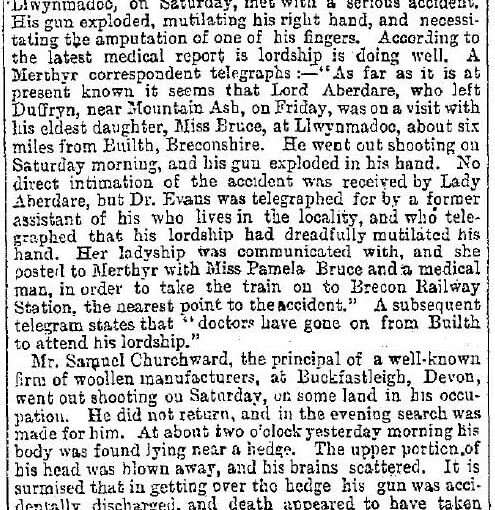Chatham Standard – Wednesday 28 June 1950
FELL WHILE PICKING CHERRIES
Misadventure Verdict At Inquest On Farm Labourer

As the result of a fall from a ladder while picking cherries, 79-years-old Henry James Lockyer, a farm labourer, of 13, Pembury-st., Sittingbourne, died later in St Bartholomew’s Hospital, Rochester, from shock and a fractured pelvis.
The accident occurred about 4.20 p.m. on Monday in last week at Gore Court Orchard, Park Drive, Sittingbourne, where Lockyer had picked cherries for several summers.
At an inquest held in the Guildhall, Rochester, last Thursday, Albert John W. Tyler, of 15, Waterloo-rd., Sittingbourne, said Lockyer was picking cherries alone in the tree next to him, and was about half-way up a 30 stay ladder.
“I heard a thud and then saw him lying on his back at the foot of his ladder. I went to him and then fetched help,” said witness.
He added that the ladder was in good condition and was still firmly in position after the fall.
This was corroborated by Sidney H. Weller, of 56, Park Drive, Sittingbourne, manager of the orchard, who said that he surmised from the position of the ladder and basket that Lockyer had been picking the bough behind him.
P.C. Robert Walter, who was called to the scene of the accident, stated that he found the ladder was firmly fixed and in good condition.
Dr. G. P. Deverham, of St. Bartholomew’s Hospital, Rochester, said that he examined deceased and came to the conclusion that death was not due to anything other than the fall. There were no signs of a stroke previous to the fall.
Mrs. Amy Sophia Atkinson, a niece of Lockyer’s, gave formal evidence of identification.
A verdict of misadventure was recorded.
Analysis and Explanation:
This article reports on the tragic death of Henry James Lockyer, an elderly farm labourer who suffered a fatal accident while picking cherries. The details provided in the inquest reveal:
- Circumstances of the accident:
Lockyer was experienced in cherry picking and was working alone on a ladder at Gore Court Orchard. Witnesses confirmed the ladder was stable, suggesting the fall was accidental rather than caused by faulty equipment. - Medical perspective:
Dr. Deverham’s testimony ruled out any pre-existing medical conditions such as a stroke, indicating that the fall itself was the direct cause of death. - Legal process and verdict:
The coroner returned a verdict of “misadventure,” which means the death was accidental and occurred without any deliberate intent or negligence. This was a common verdict in cases where no foul play or negligence was found.
Inquests in 1950:
Inquests during the 1950s in Britain were typically conducted to investigate sudden, unexpected, or suspicious deaths. They aimed to establish the cause of death without attributing blame unless negligence was evident. The process usually involved:
- Witness statements: Collected from people who were present or involved.
- Police reports: Officers would provide factual accounts of the scene.
- Medical evidence: A doctor would present the medical findings post-mortem.
- Verdict: Possible outcomes included misadventure, accidental death, natural causes, or, in rare cases, unlawful killing.
The coroner’s inquest in this case would have been a formal but relatively quick affair, reflecting the community’s desire to understand what happened without unnecessary legal complications.
Understanding Life in Chatham in the 1950s:
The details in the article give insights into life and work in 1950s Chatham and Sittingbourne:
- Occupational hazards:
Many people worked in agriculture and related trades, often well into old age, indicating a strong work ethic and economic necessity. - Community involvement:
The reporting of a farm labourer’s death highlights how closely-knit communities were, with neighbours and managers coming forward to provide statements. - Healthcare:
The mention of St. Bartholomew’s Hospital shows the reliance on local hospitals for emergency medical care. Medical treatment was relatively basic compared to modern standards. - Family and identification:
The formal identification by a family member, Amy Sophia Atkinson, reflects the practice of relying on next of kin for official processes.
This incident provides a small but poignant window into the daily lives and risks faced by agricultural workers in the mid-20th century, demonstrating how work, health, and community were closely intertwined.
The Chatham Standard

The Chatham Standard was a local newspaper serving Chatham, Kent, and the surrounding areas in England. According to the British Newspaper Archive, the publication’s available issues span from January 4, 1950, to December 21, 1999, encompassing 828 issues and 37,771 pages.
Throughout its publication history, the Chatham Standard chronicled local news, events, and issues pertinent to the residents of Chatham and the broader Kent region. The newspaper provided insights into community life, including reporting on local events, public notices, and societal changes over the decades.
In 1993, the newspaper underwent a rebranding and was known as the Medway Standard until its cessation in 1999.
The Chatham Standard’s archives offer a valuable resource for researchers and historians interested in the local history of Chatham and Kent, providing first-hand accounts and reports of the area’s social, economic, and cultural developments during the latter half of the 20th century.
Elderly Farm Labourer Falls While Picking Cherries, Dies from Injuries – Inquest Rules Misadventure. #BreakingNews #History #Sittingbourne #FarmAccident #1950sBritain




